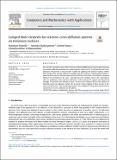Files in this item
Lumped finite elements for reaction-cross-diffusion systems on stationary surfaces
Item metadata
| dc.contributor.author | Frittelli, Massimo | |
| dc.contributor.author | Madzvamuse, Anotida | |
| dc.contributor.author | Sgura, Ivonne | |
| dc.contributor.author | Venkataraman, Chandrasekhar | |
| dc.date.accessioned | 2017-11-28T15:30:13Z | |
| dc.date.available | 2017-11-28T15:30:13Z | |
| dc.date.issued | 2017-12-15 | |
| dc.identifier | 250702071 | |
| dc.identifier | d60a3e10-d631-423b-98f3-c45752ca342e | |
| dc.identifier | 85028458539 | |
| dc.identifier | 000418985800008 | |
| dc.identifier.citation | Frittelli , M , Madzvamuse , A , Sgura , I & Venkataraman , C 2017 , ' Lumped finite elements for reaction-cross-diffusion systems on stationary surfaces ' , Computers and Mathematics with Applications , vol. 74 , no. 12 , pp. 3008-3023 . https://doi.org/10.1016/j.camwa.2017.07.044 | en |
| dc.identifier.issn | 0898-1221 | |
| dc.identifier.uri | https://hdl.handle.net/10023/12182 | |
| dc.description | All the authors (AM, IS, CV, MF) thank the Isaac Newton Institute for Mathematical Sciences for its hospitality during the programme (Coupling Geometric PDEs with Physics for Cell Morphology, Motility and Pattern Formation; EPSRC EP/K032208/1). This work (AM) has received funding from the European Union's Horizon 2020 research and innovation programme under the Marie Sklodowska-Curie grant agreement No 642866. AM and CV acknowledge support from the Engineering and Physical Sciences Research Council (EP/J016780/1) on Modelling, analysis and simulation of spatial patterning on evolving biological surfaces and the Leverhulme Trust Research Project Grant (RPG-2014-149) on Unravelling new mathematics for 3D cell migration. AM was partially supported by a fellowship from the Simons Foundation. AM is a Royal Society Wolfson Research Merit Award Holder, generously funded by the Wolfson Foundation. | en |
| dc.description.abstract | We consider a lumped surface finite element method (LSFEM) for the spatial approximation of reaction-diffusion equations on closed compact surfaces in R3 in the presence of cross-diffusion. We provide a fully-discrete scheme by applying the implicit-explicit (IMEX) Euler method. We provide sufficient conditions for the existence of polytopal invariant regions for the numerical solution after spatial and full discretisations. Furthermore, we prove optimal error bounds for the semi- and fully-discrete methods, that is the convergence rates are quadratic in the meshsize and linear in the timestep. To support our theoretical findings, we provide two numerical tests. The first test confirms that in the absence of lumping numerical solutions violate the invariant region leading to blow-up due to the nature of the kinetics. The second experiment is an example of Turing pattern formation in the presence of cross-diffusion on the sphere. | |
| dc.format.extent | 1072792 | |
| dc.language.iso | eng | |
| dc.relation.ispartof | Computers and Mathematics with Applications | en |
| dc.subject | Surface finite elements | en |
| dc.subject | Mass lumping | en |
| dc.subject | Invariant region | en |
| dc.subject | Reaction-cross-diffusion | en |
| dc.subject | Convergence analysis | en |
| dc.subject | Pattern formation | en |
| dc.subject | Rosenzweig-MacArthur | en |
| dc.subject | QA Mathematics | en |
| dc.subject | NDAS | en |
| dc.subject.lcc | QA | en |
| dc.title | Lumped finite elements for reaction-cross-diffusion systems on stationary surfaces | en |
| dc.type | Journal article | en |
| dc.contributor.sponsor | en | |
| dc.contributor.institution | University of St Andrews. Applied Mathematics | en |
| dc.identifier.doi | 10.1016/j.camwa.2017.07.044 | |
| dc.description.status | Peer reviewed | en |
| dc.identifier.grantnumber | 642866 | en |
This item appears in the following Collection(s)
Items in the St Andrews Research Repository are protected by copyright, with all rights reserved, unless otherwise indicated.

